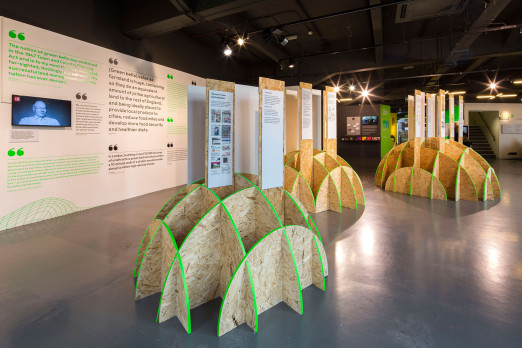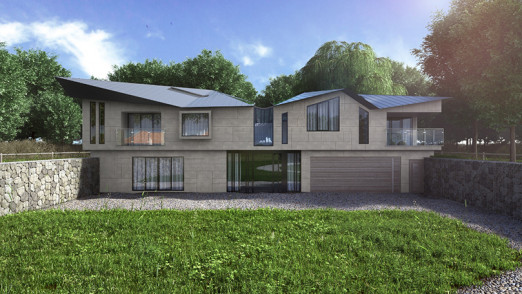The title of the event, its practicality, its direct bluntness, cut through the anxiety and raised hackles that often accompanies any mention of the phrase – the green belt. One of the issues that is becoming clear as these debates around the green belt unfold, is that the context for planning and legal definitions is a wide cultural understanding - and misunderatnding.
Ben Webster, Environmental Editor of The Times introducing the debate, noted the timeliness as the Secretary of State for Communities and Local Government had just announced the biggest development on the green belt since 2005 with 1500 new homes in Gloucester.
(Ben Webster, Environmental Editor of The Times)
The previous biggest development had been approved by the then Labour Minister John Prescott, who, Webster noted, featured in the current Green Belt exhibition at The Building Centre: “The Green Belt is a great Labour achievement and we mean to build on it.”
A classic example of a John Prescott malapropism, but also unfortunately an echo of the confusion and contradictions surrounding the green belt – whether its a political strategies or the general lack of public understanding.
Green Belt or Green Field
In this instance, Ben Webster pointed out that the government’s decision meant that the original purpose of the green belt to prevent sprawl is undermined.
Some of the confusion around the terminology is perpetuated by the media. Webster pointed out that a lot of green belt isn’t green – there’s confusion between green belt and green field.
While the government is keen to address the issue of the housing shortage, it is also emphasising that they are not going to build on the green belt. That said, Webster cited the fact that the National Infrastructure Commission has pushed for 20,000 new homes to be built near stations on Crossrail 2 – many of these would be built near Chessington South station.
Legal Issues
Andy Meader is a Director at Pegasus, a Planning, Design and Environmental Consultancy, helping local authorities and people with issues of development and planning in the Green Belt. Meader was formerly a Planning Officer in Hertsmere, North London, therefore familiar with the different perspectives and interests at stake.
(Andy Meader, a Director the Planning, Design and Environmental Consultancy, Pegasus)
Meader unpacked what can be built without permission under the General Permitted Development Order, which treats the green belt the same as elsewhere – unlike Conservation Areas.
Openness
So for example Meader shared an anecdote about his neighbours who asked him how a farmhouse nearby could be given permission for conversion to a private dwelling – simply, planning permission wasn’t needed.
The National Planning Policy Framework will allow building for example on previous developments as long as the new building doesn’t have a greater impact on the ‘openness’ of the land.
Meader gave the example of a dilapidated tourist facility (see image above) that was denied development under the previous rules (despite being supported by locals), but when the NPPF was introduced in 2012, they got the go ahead for six dwellings.
Meader also unpacked the category of Very Special Circumstances which allows you to make a case to the Council when your building isn’t on a previously developed site.
Innovative Design
This could include an innovative design such as a development of an old farm site in Taplow, where a client wanted to build an interesting piece of architecture pushing Passive House technology. The council refused but with planning and landscape input, it was approved on appeal.
(Andy Meader, a Director the Planning, Design and Environmental Consultancy, Pegasus)
Human Rights
Perhaps somewhat surprisingly, permission to build can be given on the basis of an appeal to Human Rights. Meader referred to a situation where a house had been burned down years ago and the original request to construct a replacement house was denied by the council who said it would be a new house.
The appeal was successful on the grounds that their human rights would be breached if they weren’t allowed to live in a house on the site they originally owned.
Wear a tin hat
In summary, Meader suggested to check if you are going to need planning permission for the project; if it does, then best avoid it. There are going to be opportunities out there to make a case for developing parts of the green belt, especially previously developed sites.
If you find yourself in a Very Special Circumstances case, it’s about ensuring the benefit of the scheme can really be shown. Most of all, he concluded, be aware that subject to what you are proposing, it can be controversial building in the Green Belt, so "get your tin hat ready."
Living Development
James Lord, Head of Landscape Design and Partner at HTA Design, Board Trustee of the landscape Institute, introduced a project called Hanham Hall, 7 km east of Bristol. The hall itself is a 17th Century grade 2-listed building.
It was converted into a psychiatric hospital in 1900 and developed over the 20th Century for that purpose. It was run down and eventually closed in 2000. Through the 90s and 00s there were various failed attempts at getting planning approval to develop the site as housing.
That was until 2007 when the site was promoted by the Homes and Community Agency as a Carbon Challenge site – a prototyping project for Gordon Brown’s Eco Towns – promoting sustainable homes code level 6 (new at the time, but this year all homes will have to be built to code level 6, carbon neutral standard).
HTA Design won the site in competition with Barratt Homes, with the planning application of 2008 being approved in 2009, and the development was completed this year.
Embedded in the wider community
There are 187 mixed tenure homes, and it is in the green belt. This affected the design of the site in a number of ways, including the desire to retain views and keep the feeling of openness to the countryside – a third of the site was undeveloped and given over to open space.
It was integrated into the fabric of Hanham, respectful of the environment and the countryside around it. It has become a good neighbour to the community.
Social Spaces
Rather than giving a talk, Lord showed a video, and while it was a promotional piece, it was a highly effective piece of storytelling with anecdotes: from happy householders impressed by Hanham Hall’s eco facilities such as solar power (one couple wash their clothes in the harvested rainwater); to a local councillor originally suspicious of the high density housing, then persuaded by the greenhouses, allotments and most tellingly, a community hall that was not just for the residents of the new build. It acts as a facility and space of encounter between the new residents and the existing community.
(Allotments at Hanham Hall)
This community hall was originally designated for use as flats but HTA fought for it to be a space for public use. In the Q&A with the audience afterwards, James Lord explained that they also wanted it to function as a workspace, so the community wouldn’t be deserted during the day as everyone heads off to work – among other things it currently houses 20 work units.
Common Good
The design borrowed from the idea of the urban ‘stoop’, of people sitting outside, which also encouraged social encounters missing from traditional suburban neighbourhoods. The quality of community also perhaps benefitted from a degree of self-selection; there was a sense that the people were all keen on the idea of a neighbourhood built around the idea of sustainability – or perhaps it was the buildings and space that fostered this sensibility.
The project was shortlisted for the “RIBAJ MacEwen Award: Architecture for the Common Good.”
Strategic Gaps
Final speaker Merrick Denton-Thompson, President Elect of the Landscape Institute, argued that we all agree on the founding principles of the green belt – we want to see places keep a sense of identity - but the pattern of green belt isn’t complete, citing his local area. The strategic planning authority in Hampshire said, "we don’t want green belt, we want strategic gaps."
The thinking was that we want strong spatial policies. We will have strategic, regional, local gaps, enabling settlements to breathe.
Greenfenced Strangulation
However, each change of government and political party removed existing organisations and frameworks. Denton-Thompson said we need more consistency around the criteria being adopted for developing green belt. Equally, we need to question greenfenced ‘strangulation’ – Guildford being a good example.
Richer Idea of Green Belt
Most of all, and most persuasively, he argued that green belt is a single-issue designation. We need a richer designation which includes more intelligent, multi-functional services, a more encompassing concept – resilience to climate change, accessibility for health and well-being, and biodiversity.
Denton-Thompson argued that regarding the green belt we have simply failed in dealing with management of resources. We need other systems to maintain management of the land and a strategic review by Government looking at structured new development.
In summary, green belt has a body of legislation, a network of experts and authorities analysing, making cases and passing judgement, and commercial and political interests hovering round its grey areas. Most of all it is a particular kind of geography with significant cultural and social power.










